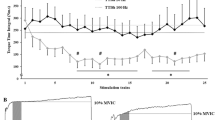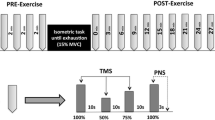Abstract
The development of fatigue during the transmission of excitation through the frog neuromuscular synapse was studied. The blocking of neuromuscular transmission during fatigue was shown to be based on a reduction in the quantum composition of the mediator. Liberation of the mediator is disturbed not by a decrease in the reserves of acetylcholine in motor nerve endings, but by a decrease in the probability of liberation of each quantum.
Similar content being viewed by others
Literature cited
I. S. Beritov, The General Physiology of the Muscular and Nervous System [in Russian], Vol. 1, Medgiz, Moscow (1959).
I. G. Validov, "The mechanism of action of calcium on the fatigued nerve-muscle preparation," Uch. Zap. Kazan. Gos. Univ.,96, 12 (1936).
I. G. Validov, "The effect of tetanization on the fatigued nerve-muscle preparation," Uch. Zap. Kazan. Gos. Univ.,101, 55 (1941).
I. A. Vladimirova, "The effect of potassium, calcium, and anoxia on presynaptic blocking in motor nerve endings," Fiziol. Zh. SSSR,50, 464 (1964).
I. N. Volkova, E. E. Nikol'skii, and G. I. Poletaev, "Blocking action potentials and contractions of frog skeletal muscle by transverse division of muscle fibers," Fiziol. Zh. SSSR,61, 1433 (1975).
M. A. Kamenskaya and M. V. Kirzon, "Analysis of the process of fatigue of the isolated frog skeletal muscle by short tetanization at different frequencies," Fiziol. Zh. SSSR,55, 1369 (1969).
P. G. Kostyuk, "Mechanism of Wedensky inhibition of muscular contraction," in: The Biophysics of Muscular Contraction [in Russian], Nauka, Moscow (1966), pp. 89–99.
G. A. Nasledov, "The relative refractoriness of the end-plate of the motor nerve of frog skeletal muscle," Fiziol. Zh. SSSR,48, 349 (1962).
G. A. Nasledov and V. V. Fedorov, "Summation of synaptic responses during repetitive stimulation of phasic and tonic fibers," Fiziol. Zh. SSSR,52, 757 (1966).
E. E. Nikol'skii and G. I. Poletaev, "Effect of prolonged low-frequency stimulation on acetylcholine sensitivity of the postsynaptic membrane during blocking of neuromuscular transmission," Neirofiziologiya,7, 550 (1975).
E. E. Nikol'skii, G. I. Poletaev, and É. G. Ulumbekov, "The role of cytoplasmic microtubules in the liberation of acetycholine quanta," Fiziol. Zh. SSSR,59, 571 (1973).
T. N. Oniani and S. V. Dzhibladze, "Differences in the mechanisms of fatigue of tetanic and tonic neuromotor units," in: Nervous Mechanisms of Motor Activity [in Russian], Nauka, Moscow (1966), pp. 26–33.
G. I. Poletaev and E. E. Nikol'skii, "Lowering of the probability of mediator liberation as one cause of blocking of neuromuscular transmission during prolonged low-frequency stimulation of the motor nerve to a skeletal muscle," in: The Physiological Role of Mediators [in Russian], Kazan' University Press, Kazan' (1972).
A. I. Shapovalov, The Cellular Mechanisms of Synaptic Transmission [in Russian], Meditsina, Moscow (1966).
J. A. B. Barsted and L. Lilleheil, "Transversely cut diaphragm preparation from rat," Arch. Internat. Pharmacodyn.,175, 379 (1968).
J. del Castillo and B. Katz, "The effect of magnesium on the activity of motor nerve endings," J. Physiol. (London),124, 553 (1954).
D. E. Elmquist and D. M. J. Quastel, "Presynaptic action of hemicholinium at the neuromuscular junction," J. Physiol. (London),177, 463 (1965).
J. I. Hubbard, "Mechanism of transmitter release," Prog. Biophys. Molec. Biol.21, 33 (1970).
J. I. Hubbard, R. Llinas, and D. M. J. Quastel, Electrophysiological Analysis of Synaptic Transmission, London (1969).
A. W. Liley, "The effects of presynaptic polarization on the spontaneous activity at the mammalian neuromuscular junction," J. Physiol. (London),134, 427 (1956).
A. R. Martin, "A further study of the statistical composition of the end-plate potential," J. Physiol. (London),130, 114 (1955).
A. R. Martin, "Quantal nature of synaptic transmission," Physiol. Rev.,46, 51 (1966).
M. Otsuka and Y. Nonomura, "The action of phenolic substances on motor nerve endings," J. Pharmacol. Exp. Ther.,140, 41 (1963).
J. W. Woodbury and A. J. Brady, "Intracellular recording from moving tissue with a flexibly mounted ultramicroelectrode," Science,123, 100 (1956).
Additional information
S. V. Kurashov State Medical Institute, Kazan'. Translated from Neirofiziologiya, Vol. 9, No. 1, pp. 78–85, January–February, 1977.
Rights and permissions
About this article
Cite this article
Nikol'skii, E.E., Poletaev, G.I. Investigation of the mechanism of neuromuscular transmission blocking during low-frequency nerve stimulation. Neurophysiology 9, 58–63 (1977). https://doi.org/10.1007/BF01063546
Received:
Issue Date:
DOI: https://doi.org/10.1007/BF01063546




